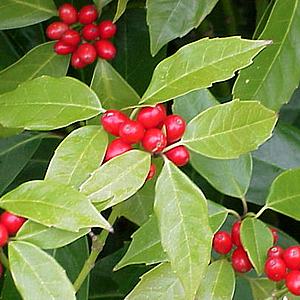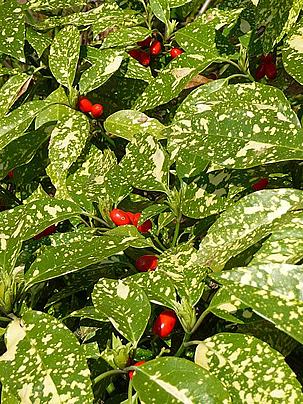The Spotted Laurel (Aucuba japonica) is a dioecious, woody shrub known for its ornamental foliage and fruit. It is recognized for its ability to adapt to adverse conditions such as pollution, shade, drought, and cold, making it a rare choice for cultivating ornamental plants. The plant has a rounded shape and is evergreen. Its leaves, typically opposite, are oval to lanceolate, leathery, shiny, and green in the typical species. However, variegated and spotted leaf forms are more common in cultivation due to their unique foliage.
Notable varieties include ‘Crotonifolia’ and ‘Golden King,’ with speckled leaves, ‘Gold Dust’ and ‘Variegata,’ featuring yellow spots, ‘Goldieana,’ with predominantly yellow leaves, ‘Nana,’ a compact variety, and ‘Rozannie,’ with flowers of both sexes. It blooms in early spring, displaying small flowers with brownish-purple petals in clusters on male specimens and axillary clusters on females. If pollinated, female plants produce beautiful clusters of bright red, durable, and toxic berries, which are avoided by birds. Each fruit contains a single seed.

In landscaping, the Spotted Laurel is used to fill spaces in shaded areas, forming informal rows, high ground cover under dense tree canopies, or in compositions with other plants in poorly lit corridors, often as a backdrop.
It serves as an excellent substitute for colorful crotons and dracenas in cold and dark locations, offering vibrant foliage with variegated, golden, and speckled varieties. It remains dense even in low light, unlike many bushes claimed to be shade-tolerant. It is long-lived and allows rejuvenation pruning in older specimens.
Planting it in pots is also interesting, where it can be used for interior decoration in spaces such as living rooms and offices. Female plants, when planted near at least one male specimen, produce clusters of red and persistent fruits, which are quite attractive.
It should be cultivated in partial shade or light shade, in well-draining soil enriched with organic matter. Watering is only necessary during the first year of establishment and extended drought. Despite tolerating various adversities, the Spotted Laurel does not withstand constant heat and humidity, especially in the soil, which can quickly lead to fungal diseases.
Therefore, it is suitable for areas with a subtropical to temperate climate. In a tropical climate, the Spotted Laurel requires shaded and cool locations, as its leaves may burn in full sun. It is also tolerant of the salinity of maritime winds. The plant can be easily propagated by seeds and cutting of woody or semi-woody branches at any time of the year.


